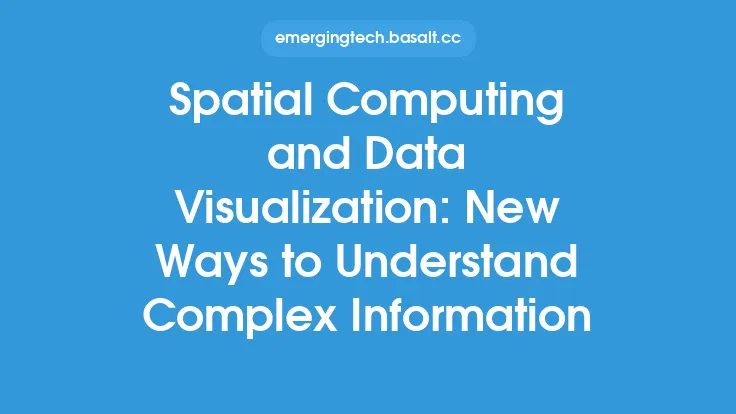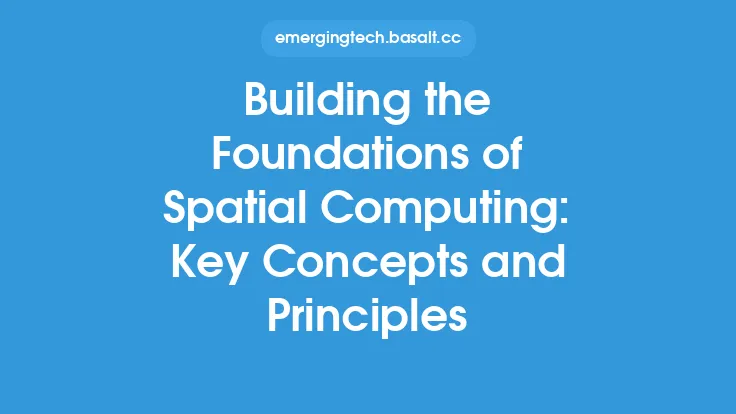Spatial computing is a term used to describe the process of using computers to understand and interact with the physical world. It involves the use of various technologies, including sensors, cameras, and other devices, to capture and process information about the environment and the objects within it. This information is then used to create a digital representation of the physical world, which can be used for a variety of purposes, including navigation, object recognition, and interaction.
Introduction to Spatial Computing Concepts
At its core, spatial computing is about creating a digital twin of the physical world. This digital twin is a virtual representation of the physical environment, including the objects, people, and other elements that exist within it. The digital twin is created using a variety of data sources, including sensors, cameras, and other devices, which capture information about the environment and the objects within it. This information is then used to create a 3D model of the environment, which can be used for a variety of purposes, including navigation, object recognition, and interaction.
Key Technologies Used in Spatial Computing
Several key technologies are used in spatial computing, including computer vision, machine learning, and sensor fusion. Computer vision is the process of using cameras and other devices to capture and process visual information about the environment. This information is then used to create a digital representation of the physical world, including the objects, people, and other elements that exist within it. Machine learning is used to analyze the data captured by the sensors and cameras, and to create a digital twin of the physical world. Sensor fusion is the process of combining data from multiple sensors and devices to create a more accurate and complete digital representation of the physical world.
Spatial Computing and Virtual and Augmented Reality
Spatial computing is closely related to virtual and augmented reality (VR/AR) technologies. In fact, spatial computing is a key component of many VR/AR systems, as it provides the ability to track the user's position and orientation in the physical world, and to create a digital representation of the environment that can be used to render virtual objects and scenes. Spatial computing is also used in AR systems to enable the tracking of objects and people in the physical world, and to create a digital representation of the environment that can be used to render virtual objects and scenes.
Spatial Computing and 3D Modeling
Spatial computing is also closely related to 3D modeling, as it provides the ability to create a digital representation of the physical world. This digital representation can be used for a variety of purposes, including navigation, object recognition, and interaction. 3D modeling is a key component of many spatial computing systems, as it provides the ability to create a detailed and accurate digital representation of the physical world. This digital representation can be used to simulate the behavior of objects and systems, and to predict how they will interact with the physical world.
Applications of Spatial Computing
Spatial computing has a wide range of applications, including robotics, autonomous vehicles, and smart buildings. In robotics, spatial computing is used to enable robots to navigate and interact with their environment. This includes the use of computer vision and machine learning to recognize objects and people, and to create a digital representation of the environment that can be used to plan and execute tasks. In autonomous vehicles, spatial computing is used to enable vehicles to navigate and interact with their environment. This includes the use of sensors and cameras to capture information about the environment, and the use of machine learning to analyze this data and make decisions about how to navigate.
Challenges and Limitations of Spatial Computing
Despite its many potential applications, spatial computing is still a relatively new and emerging field, and there are many challenges and limitations that must be addressed. One of the main challenges is the need for more accurate and reliable sensors and devices, which can capture high-quality data about the environment. Another challenge is the need for more advanced machine learning algorithms, which can analyze this data and create a digital representation of the physical world. Additionally, there are many ethical and social implications of spatial computing that must be considered, including the potential for surveillance and the impact on privacy.
Conclusion
In conclusion, spatial computing is a powerful and emerging technology that has the potential to revolutionize the way we interact with the physical world. By creating a digital twin of the physical world, spatial computing enables a wide range of applications, including navigation, object recognition, and interaction. While there are many challenges and limitations that must be addressed, the potential benefits of spatial computing make it an exciting and important area of research and development. As the technology continues to evolve and improve, we can expect to see many new and innovative applications of spatial computing in the years to come.





